Africa. The expanse of savanna stretches out like a Vincent Van Gogh masterpiece. The earth tones swirl into the crystal-blue sky… The flat-topped acacia trees are spotted here and there, filling in the gaps… And the elephants guard their calves like a bird guards its nest.
Elephants. Guardians of the great expanse of African and Asian history. They lumber along as if they’re floating. They hold mysteries we may never know the meanings of.
To talk about elephants is similar to a religious experience for me. I honor, respect, and remain in awe of them. To forget about their importance would be ignorant. And to lose them, tragic!
Words like “endangered” and “critically endangered” are scary at best. But that’s where the future of elephants lies if we don’t each take personal responsibility for them.
Additionally, elephants in zoos, circuses, and roadside exhibits develop foot diseases and arthritis due to their confined areas. They’re born to roam, and when so much space is taken away, they suffer.
So, let’s talk about these great mammals of might. Their persistence, their sensitivity, and their power. Afterward, we hope you’ll have a greater love for them. And the motivation to save their lives.
12 Amazing Facts About Elephants
- On average elephants have a height of 3 meters
- The average weight of an elephant is 4,000 to 7,500 kg
- There are 3 different species of elephants recognized by their ears
- The trunk of elephants consists of 150,000 muscle units
- The tusk of elephants are large incisors
- Almost 150 kg of food is eaten by elephants on daily basis
- They are primarily located in savannas, grasslands, and forests
- An elephant’s skin is typically 2.5cm thick in most areas
- Elephants become sexually mature at the age of 10-14 years
- Elephants have a gestation period of 22 months
- A typical elephant in the wild has a lifespan of 60-70 years
- The Asian elephant is endangered, while the African elephant is vulnerable
Elephant Facts
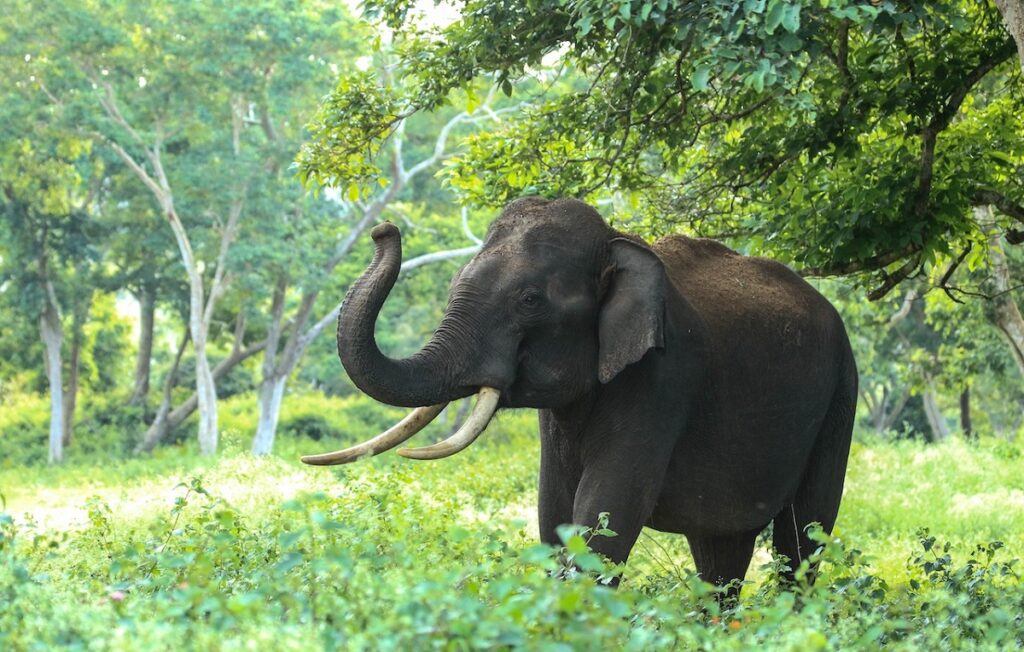
We’re here to make sure everyone knows about these fabulous beings – About their offspring, their ivory tusks, what’s in an elephant’s trunk, and even how they migrate.
If you’ve ever wondered about elephants’ diets or skin or if they make any sounds besides trumpeting, you’re in the right place. So let’s talk about “everything elephant.”
Elephant Is the World’s Largest Land Animal. (Live Science)
The weights of African elephants range between 5,000 to 14,000 lbs. In comparison, the hippopotamus can weigh 3,000-9,000 lbs, and the rhino comes in at approximately 2,000 lbs. The only animal that’s bigger than an elephant, a marine mammal, is the Antarctic blue whale, which weighs up to 400,000 lbs. (approximately 33 elephants). (source)
There Are 3 Different Species of Elephants Which Are Recognized by Their Ears. (University of California)
Three elephant species:
- African Savanna (Bush) – Larger ears shaped like the African continent
- African Forest – Larger ears, also shaped like the African continent
- Asian – Smaller ears shaped like the Indian subcontinent (source)
The Trunk of Elephants Consists of 150,000 Muscle Units. (Science Direct)
The entire human body only has around 639 muscles. And the trunk is precise in its functions. It can pinpoint a single blade of grass or lift extremely heavy loads. (source)
The Trunk Serves Vital Roles Such as Breathing, Drinking, and Eating. (National Geographic)
It also aids in grabbing and smelling things. Plus, that’s where their glorious trumpet comes from. They have two “fingers” on the end of their trunks that help them pick up things. Asian elephants only have one “finger.” (source)
An Elephant’s Skin Is Typically 2.5 cm (Not Quite an Inch) Thick in Most Areas. (WWF)
Their thick skin can retain up to 10 times more water than flat skin since it’s folded and wrinkled. Taking regular dust baths helps protect it from sunburn. They also take mud baths. (source)
Elephants Become Sexually Mature at the Age of 10-14 Years. (Tsavo Trust)
Males go through a ‘musth’ period, which means they secrete serum testosterone, and during this time, a male can behave erratically and highly aggressively. ‘Musth’ is the Hindi word for ‘intoxicated.’ (source)
Elephants Have a Gestation Period of 22 Months. (Science)
This is the longest gestation period of any mammal. Elephants have 11 corpus luteums, glands that control hormone levels during pregnancy, but most mammals have only one. (source)
Depending on the Food Availability, Elephants Migrate Seasonally. (Mangabay)
In 2016, a male elephant named Morgan migrated 130 miles from Kenya to Somalia. He spent a day there and then returned home, but researchers don’t know the reason why. (source)
Over the Past Century, Nearly 90% of African Elephants Have Been Decimated. (Action for Elephants)
Over 5 million elephants existed in Africa 100 years ago. There were 1.3 million in 1979.
From 1979-1989, over 50% of the elephant population were slaughtered. (source)
The Asian Elephant Is Endangered, While the African Elephant Is Critically Endangered. (IUCN)
And their numbers are decreasing. There are steps we can take to change this horrific predicament. Otherwise, elephants will cease to exist on our watch. (source)
Facts About Elephants
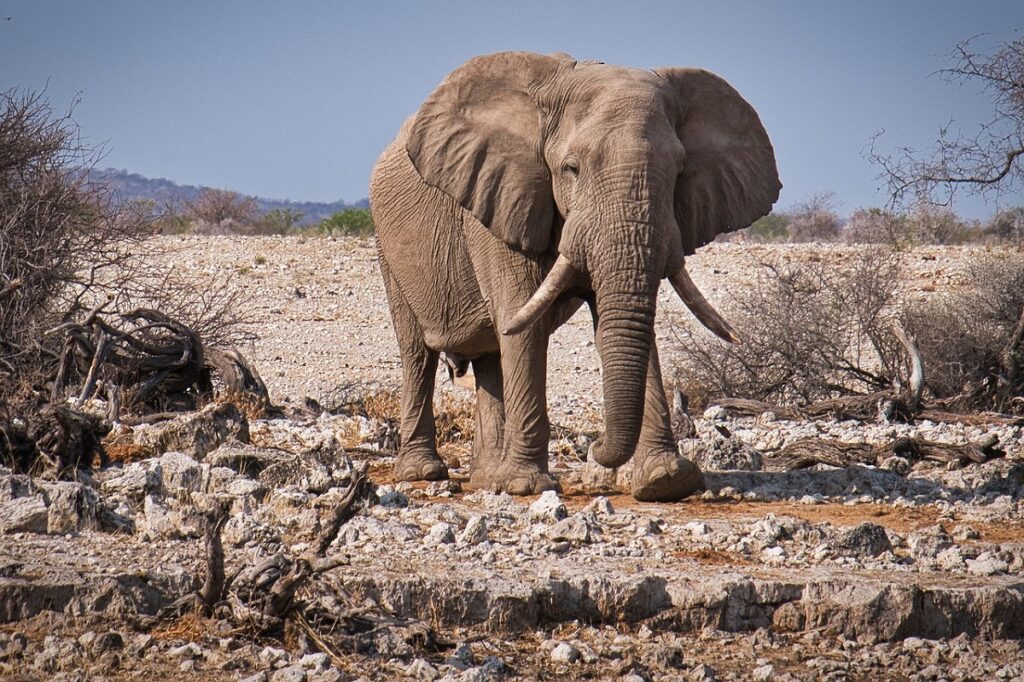
Let’s embark on a journey into the majestic world of elephants, where wisdom, strength, and sheer wonder intertwine in these fascinating facts.
Elephant Size
On Average, Elephants Have a Height of 3 Meters. (Seaworld.org)
This is around 10 feet tall. An adult male African savanna elephant was the largest ever recorded and was 13 feet tall at the shoulder. African elephants are larger than Asian ones. (source)
The Average Weight of an Elephant Is 4,000 to 7,500 kg (8,800 lbs to 16,500 lbs.) (WWF)
Males reach their full size at 35-40 years. Males continually gain weight over their lifetimes, but not females. This may correlate to a female’s peak reproduction age.
At Birth, a Baby Elephant Can Weigh 120 kg. (Seaworld.org)
They can weigh 200-250 lbs. They’re about 3 feet tall and recognize their mothers by scent, touch, and sound. Calves are typical “Mama’s babies” and stay by them for the first few months. (source)
Elephant tusks
The Tusks of Elephants Are Large Incisors, Appearing at the Age of 2 Years Old. (Seaworld.org)
In protected areas like reserves, tusklessness can be as low as 2 percent. Some elephants are born without tusks, but most, both male and female African elephants, have them. Moreover, only male Asian elephants have large tusks.
After being killed for decades from war and poaching, most Asian elephants evolved into being tuskless.
Elephant Tusks, Made of Valuable Ivory, Often Pose a Danger. (WWF)
They are used to defend themselves against other animals and each other. Elephants are protective of each other, especially after females give birth and towards herd members who are ill. (source)
Elephants Communicate with Each Other Through Vibrations. (Royalsocietypublishing.org)
Elephants can communicate seismically or through vibrations of the Earth and its crust.
Researchers have also discovered they respond (move) in response to the acoustic sound of bees, human voices, tiger growls, elephant alarm rumbles, and tourist vehicles. (source)
What Do Elephants Eat
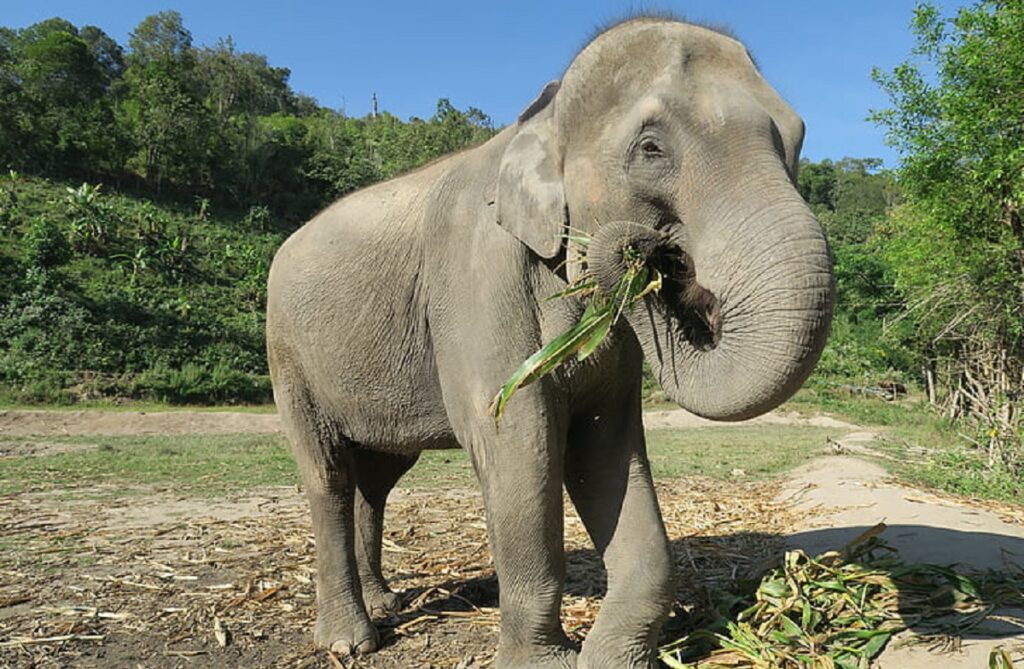
Elephants Eat Grasses, Leaves, Shrubs, Fruits, and Roots, Varying Their Diet with the Seasons. (Seaworld.org)
They will eat woody parts of trees and shrubs – twigs, barks, and branches – when it’s dry. Three-quarters of their day is usually spent eating. According to World Wildlife Fund – WWF, elephants need to eat up to 150 kgs (330 lbs) of food per day.
Elephant Habitat
They Are Primarily Located in Savannas, Grasslands, and Forests. (Seaworld.org)
Forest elephants live in:
Tropical forests in Central Africa and in several habitats of West Africa
Savanna elephants live in:
Open country in grasslands and deserts in Sub-Saharan Africa
Elephants Thrive in Various Habitats, Including Deserts, Swamps, and Highlands in Africa and Asia. (Seaworld.org)
Although savanna elephants and desert elephants look similar, the desert elephant has a lower body mass. This is probably due to less vegetation in the area. Desert elephants also seem to have bigger feet, probably due to their need to cross sandy plains and dunes.
How Long Does an Elephant Live
A Typical Elephant in the Wild Has a Lifespan of 60-70 Years. (WWF)
These years are spent living in the way elephants are supposed to live – wild and free. They can forage, mate, and migrate freely.
In Captivity, Elephants Live Up to 40 Years. (LC Animal – Last Chance for Animals, National Geographic)
Female Asian elephants in zoos only live about 19 years. The reasons could be due to the emotional effects of being in captivity, obesity, and foot infections.
Fun Facts About Elephants
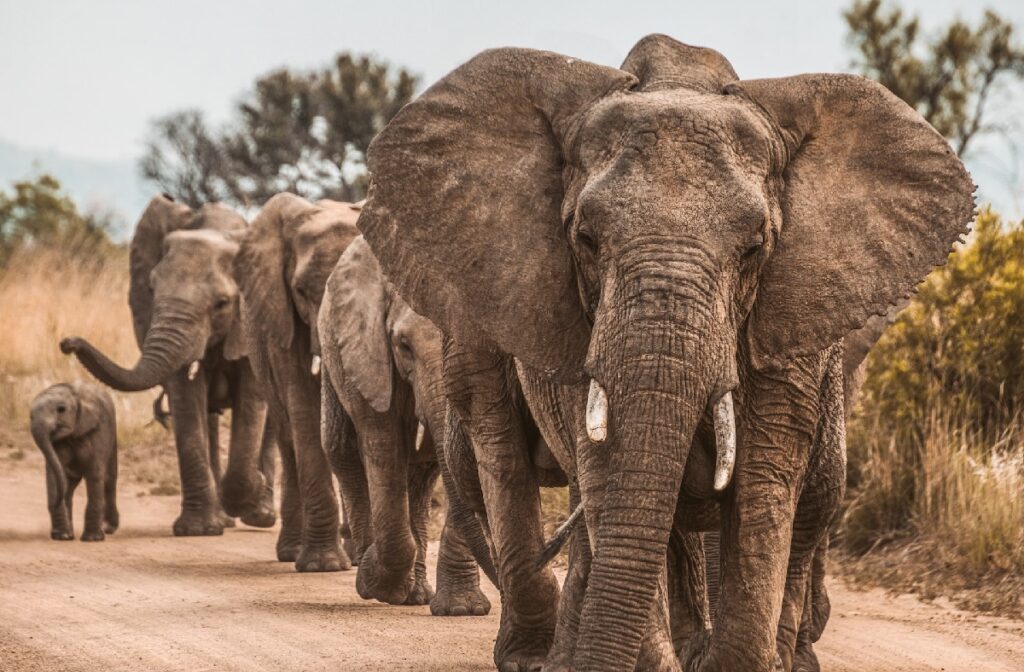
Let’s step into the realm of elephants and uncover delightful tidbits about these gentle giants.
Elephants Develop Their Own Natural Sunscreen Through Mud. (Tvaso Trust)
If you’ve ever watched a wildlife show, you’ve probably seen an elephant throwing dirt on its back. This is fairly constant, and mothers even teach their young the behavior. Dirt acts as a sunscreen and is a way to deter bugs and ticks. (source)
Elephants Can Distinguish Languages. (Phys.org)
They can decipher the differences between the accents of Maasai warriors, who carry spears, and less dangerous people like those in the Kamba.
They also respond to the voices of men, young boys, and women within the same group. They become more defensive, even huddling in groups, when hearing the voices of men. (source)
Elephants Are Proficient Swimmers. (National Geographic)
Freshwater is their favorite since saltwater burns their eyes and dries the skin. Logging was banned in 2002, and a logging elephant named Rajan lived the rest of his life on Havelock Island, where he died in 2016. His photograph and story are simply incredible.
Elephants Are Highly Social and Compassionate Animals. (PBS.org)
They stay in groups that consist of direct relatives. When calves (baby elephants) are born, they celebrate by bunching together, trumpeting, and flapping their ears.
One African herd was observed traveling slowly since one of its members had a broken leg. (source)
For Survival, Elephants Rely on Knowledge Passed Down by Their Elders. (Phys.org)
Adult males and females communicate knowledge of behaviors and survival skills to calves and future generations. Behavioral changes can contribute to expanding an elephant’s range even if it differs from its core habitat. (source)
Asian Elephants Excel in Math Intelligence. (New Scientist)
Not only can they give answers to basic math questions, they do it with almost 90% accuracy. Pigeons to chimpanzees are known to do this, too, but it may be surprising to learn that elephants are just as smart. (source)
Elephants Can Learn More Than 60 Commands. (International Elephant Foundation)
Fortunately, most circuses don’t use live animals anymore, but when they did, an elephant’s ability to learn commands was on full display. In comparison, a dog can learn up to 100 words. (source)
Elephants Have the Ability to Digest Their Food with Less Than 50% Efficiency. (Elephant Conservation)
They have poor digestive systems, and the rest of their food passes through their bodies and is eliminated. Plants/seeds that do pass can germinate and turn into new growth. (source)
Interesting Facts About Elephants
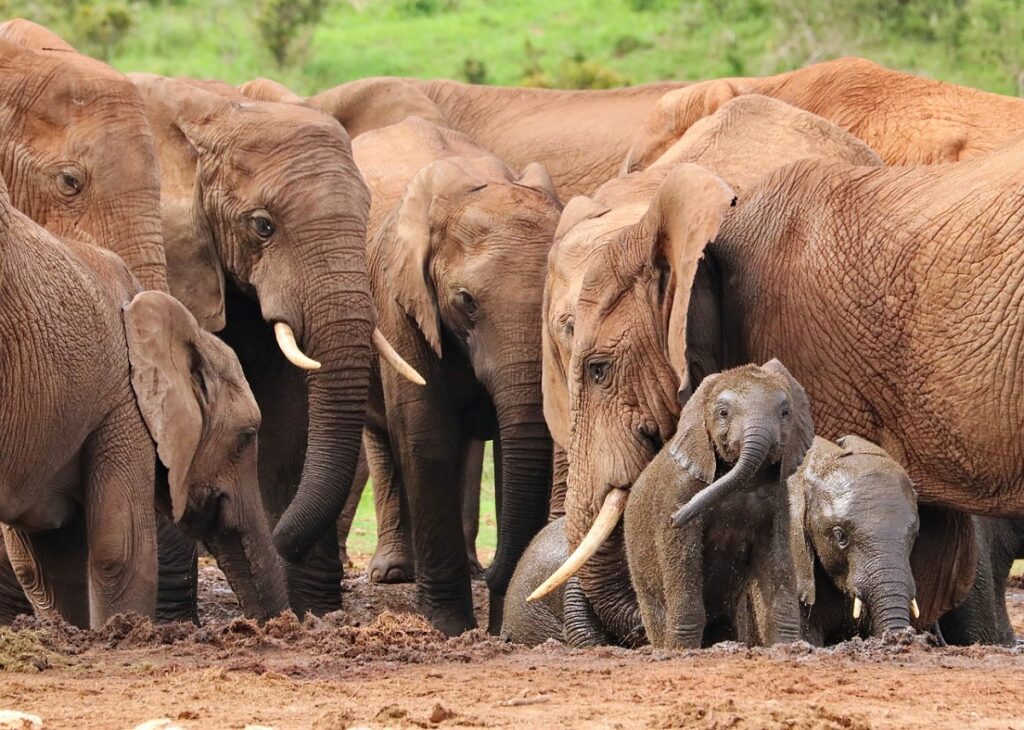
Let’s explore some more intriguing insights about these gorgeous animals.
Within 20 Minutes of Birth, a Baby Elephant Is Able to Stand. (Seaworld.org)
Elephants have one calf at a time, rarely twins. All family females raise the calf, including mothers or matriarchs, grandmothers, sisters, and aunts. (source)
Elephants Have Remarkable Memory Skills. (Wildlife SOS)
Elephants can remember migration routes and the locations of water sources and other places. This is how they’re able to navigate and travel such long distances (30-40 miles daily). It’s also how they recognize members of their own families as well as others. (source)
Interestingly, Elephants Can Listen Through Their Feet. (University of Oxford)
Can you imagine hearing through your feet? These massive animals register low-frequency noises or rumbles caused by things up to 20 miles away. (source)
Each Elephant Creates One Tonne of Poop Weekly. (National Geographic)
In the mid-2000s, a research team developed a network of sources to be able to create maps and eventually identify poachers. How did they do this? By studying elephant dung to find out an elephant’s location/range. (source)
In Mount Elgon National Park, Kenya, a Troop of Elephants Utilize Their Tusks to Excavate Salt from Underground Caves. (Oxford Academic)
Elephants are smart enough to know when they’re not getting enough of their nutritional requirements. Since they need salt to help their hydration, they instinctually know to dig for it in the soil. One of the underground caves they’ve used is called Kitum Cave in Kenya.
Elephants Can Experience PTSD. (Nature)
They’re feeling (animals are sentient) symptoms that humans with PTSD do, like:
A. Depression
B. Hyperaggression
C. Abnormal startle response
D. Unpredictable asocial behavior
Even calves that witness traumatic events are considered high-risk candidates for PTSD. (source)
Despite Their Size Difference, Elephants’ Closest Living Relative Is the Rock Hyrax. (Smithsonian National Zoo)
Rock hyraxes, also called rock rabbits, are native to Africa. Though they look nothing like elephants or manatees, their other closest living relatives, they are social animals that primarily eat vegetation. (source)
Elephants Pay Respect to Their Deceased. (National Geographic)
They mourn similarly to humans. Some stand quietly over the body, some cover it with leaves and branches, and some touch it with their trunks. There are numerous instances of elephants traveling many miles to honor someone, even human, who has died.
Fun Facts About African Elephants
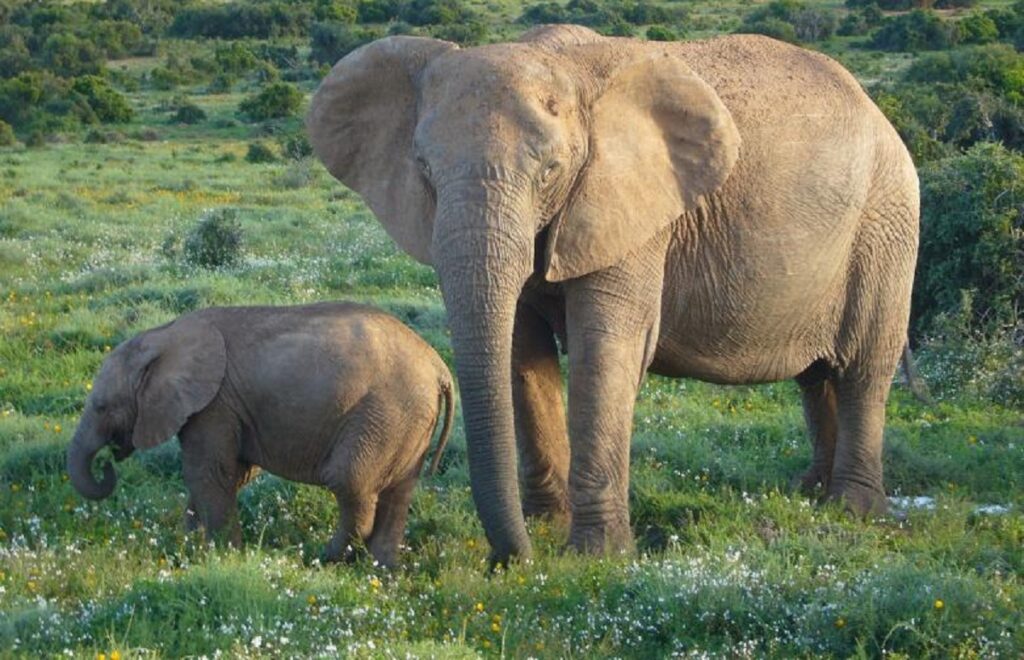
Explore the fascinating world of African elephants, where intelligence and empathy merge, trunk mysteries unravel, and the tales of their close-knit communities unfold in breathtaking splendor.
African Elephants Are Recognized as Keystone Species. (National Geographic)
This means they are highly important to their ecosystem. African elephants:
- Create watering holes for other animals
- Dung seeds create plants
- Eat trees and shrubs that create pathways for smaller animals
- Uproot trees and eat saplings, which clears plains for other animals
They Are Larger Than Asian Elephants. (National Geographic)
Asian and African forest elephants are smaller than African savanna or bush elephants, which are the largest land animals in the world. They can be found in most African countries and live from the savanna to the desert.
There Are 2 Species of African Elephants. (WWF)
In 2000, two species of African elephants were categorized – The African bush elephant and the African forest elephant. Asian elephants are their own species.
African Elephants Have Large, Fan-Shaped Ears. (WWF)
This is one of the characteristics that differentiates African elephants from Asian ones. Elephants’ ears can:
- Intimidate potential dangers if spread wide
- Helps them regulate their body temperature – thermoregulation
- Aids in communication
- Directs sounds in the environment to the inner ear – hearing
Elephant Facts for Kids
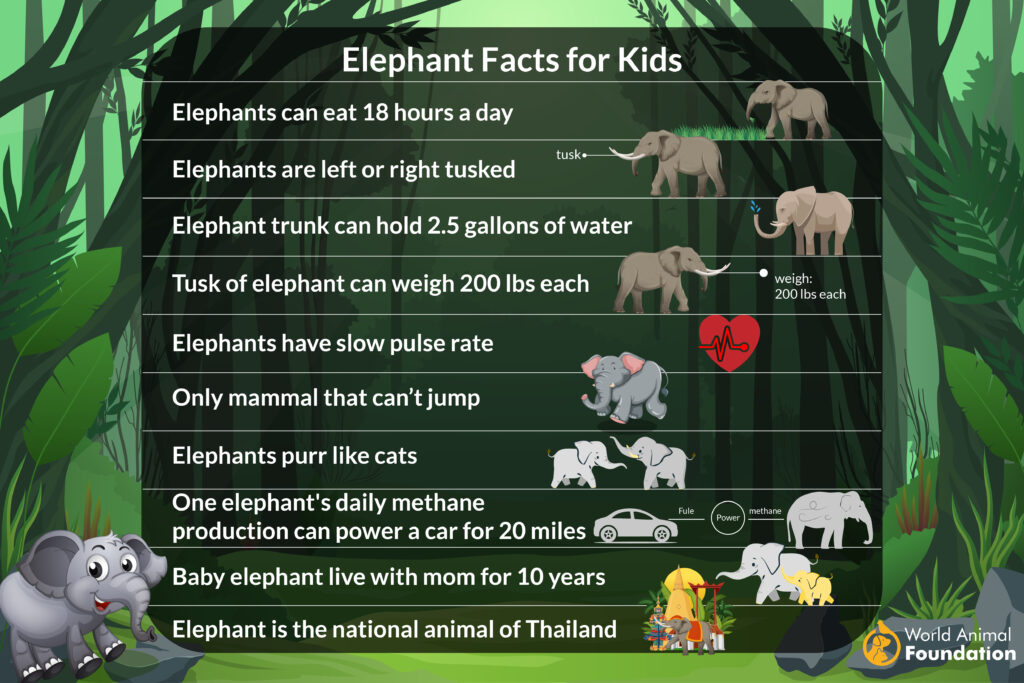
The elephant is the national animal of Thailand. Did you know they are the only mammals that can’t jump? But they can do a lot of other interesting things. They eat up to 18 hours a day, and their trunks can hold 2.5 gallons of water.
Like humans, they can be left- or right-handed, and just one of their tusks can weigh 200 lbs! Although we don’t confuse them with cats, elephants purr like them. And calves (the babies) hang out with mom for about 10 years.
How Can We Help
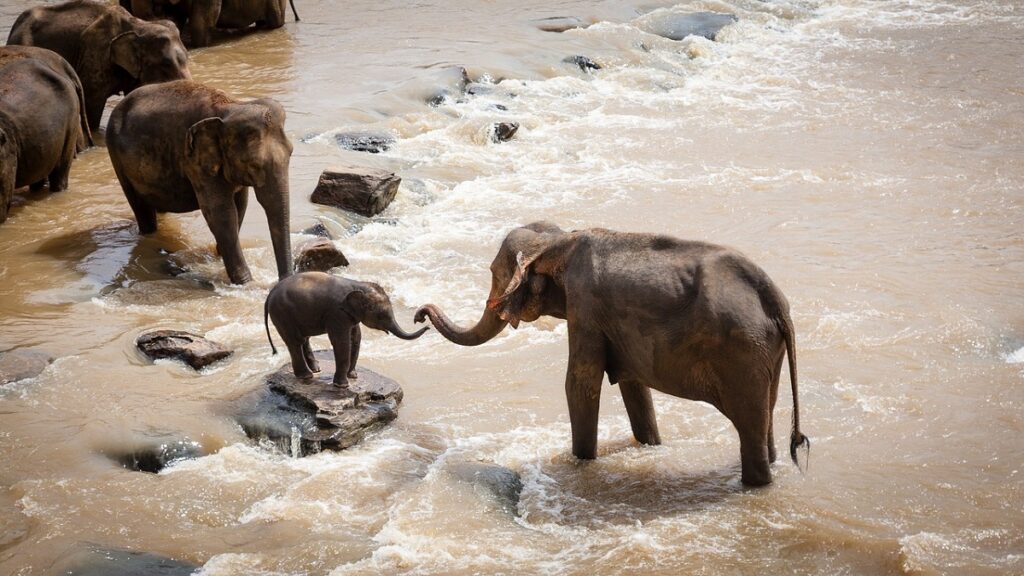
Today, there are lots of ways to help save elephants from extinction. We’ve researched and discovered reputable, life-saving organizations where you can make a difference.
African Elephants
The International Fund for Animal Welfare (IFAW) funds vital work to help save our world’s elephants.
Room to Roam is their initiative that focuses on the spaces beyond and between formal protected areas like national parks. This means that as African elephants search for food and water, they will be safe from the dangers of poaching and human-wildlife conflict.
Donate to IFAW.org – International Fund for Animal Welfare
Asian Elephants
Donate to wcs.org (Wildlife Conservation Society). Donations are accepted on their website.
Desert Elephants
On their Elephant Conservation Programme, you won’t just help desert elephants, you will also support local communities.
Adopt an Elephant
When you choose a symbolic animal adoption, you generously support WWF’s global conservation efforts. Every donation helps save endangered wildlife, protect fragile ecosystems, and build a future where people live in harmony with nature.
FAQs
How Old Are Elephants?
A typical elephant in the wild has a lifespan of 60-70 years. In captivity, elephants live up to 40 years, but according to National Geographic, female Asian elephants in zoos only live about 19 years.
How Big Are African Elephants?
On average, African adult elephants grow to be around 10 feet tall. Depending on their age and sex, elephants can weigh between 4,000 and 7,500 kgs. (8,800 lbs to 16,500 lbs.)
How Thick Is Elephant Skin?
An elephant’s skin is typically 2.5 cm (not quite an inch) thick in most areas.
What Are Elephants Known For?
- Large ears
- Trumpeting
- World’s largest land animal
- Trunks
- Tusks
- Gray and wrinkled skin
What Do Elephants Look Like?
- Large trunk
- Thick legs
- Huge head
- Wide, flat, rounded ears
- Grayish in color
Where Do African Elephants Live?
Elephants live in Africa and Asia in deserts, forests, and on plains and savannas.
Elephant Scientific Name?
The scientific name for elephants is Elephantidae.
How Much Water Does an Elephant Drink?
Elephants drink about 25–50 gallons or 100–200 liters of water a day.
What Are the Two Species of Elephants?
There are 3 elephant species:
- African Savanna (Bush)
- African Forest
- Asian
Why Are Elephants Endangered?
Poachers who hunt elephants for their tusks, which is illegal, have killed them almost to the point of extinction. Asian elephant populations have suffered from habitat loss due to humans.
Conclusion
Elephants are more than gentle giants. They have family members, social interactions, and feelings. With only 415,000 of them left in the world, we must put our capes on and let them know how much we care.
Education and activism are our biggest weapons against losing elephants forever. Up until today, human beings have been their greatest killers, so now… let’s be their rescuers!


